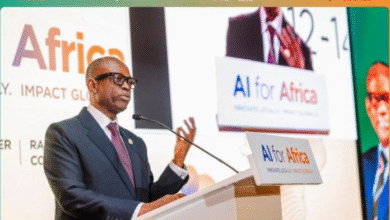Air Transport : Potential still constrained despite post–Covid recovery
While global air traffic regains momentum, Africa still represents just 2% of global traffic despite having more than 1.5 billion inhabitants. Somas Appavou is Head of External Affairs and Sustainable Development for Africa at the International Air Transport Association (IATA). Based in Nairobi, he shares his analysis on structural challenges, political bottlenecks, and opportunities to make aviation an economic driver on the continent. Interview.

Interview by Yousra Gouja
How would you describe the current state of African aviation post‑Covid? Are we seeing a sustainable recovery?
Since 2023, African air traffic has rebounded strongly, reaching 175 million passengers. Passenger traffic growth from 2024 to 2025 is estimated at around 9%, although cargo traffic has declined, partly due to geopolitical tensions. In the long term, traffic is expected to double by 2043 to reach 375 million passengers. However, despite this global upward trend, Africa captures just 2% of global air traffic. This highlights deep structural constraints, notably a too-low share of intra‑African traffic (20% versus 80% international) and public policies that continue to neglect aviation as a strategic economic lever.
Which African markets have experienced the strongest recovery, and which are lagging? Why?
Recovery is uneven across regions. East Africa has shown the most marked recovery, followed by West and North Africa. Southern Africa, by contrast, is recovering more slowly. This is due in part to differences in the economic environment, airline support policies, and capital availability. The phenomenon of “blocked funds”—where airlines cannot repatriate their revenues—also hampers growth and investment in certain markets.
What are the main infrastructure challenges facing African aviation, both on the ground (airports) and in flight (airspace management)?
Physical and digital infrastructure is significantly lagging. Investments have not kept pace with tourism or trade dynamics. Travelers come to see a country, not visit an airport. It is therefore essential that airport investments are linked to tourism and related services. Air navigation equipment and aeronautical information systems need modernization. Fragmented investment efforts, often in piecemeal fashion, impair overall efficiency. Digital technology could also enhance safety and improve the passenger experience, but remains underutilized.
Intra‑African connectivity remains limited. What can be done to improve direct links between African countries?
Today, only 19% of flights in Africa are direct between African countries. The rest depend on intra‑Africa and external hubs, lengthening journeys and increasing travel costs. An analysis of over 600 bilateral agreements (between African countries) found that 52% are restrictive, limiting frequencies or third- and fourth-freedom traffic rights. These bilateral agreements, which are not fully implemented, hinder connectivity. Additionally, operating costs for aircraft in Africa are very high compared to the global average—fuel (+17%), navigation charges (+10%), maintenance (+10%), taxes and fees (+15%), insurance (+10%), capital cost (+10%)—leading to higher ticket prices in a context where purchasing power is among the lowest in the world. Stimulating demand through price competition and better services (more frequencies) becomes impossible without political will. Harmonizing African airspace, as proposed by SAATM, is essential to eliminate non-physical constraints, notably restrictive bilateral agreements. Although the associated SAATM agreement was signed by African heads of state, its domestication remains very limited and therefore poorly enforced. Progress on visa access is notable but insufficient to stimulate regional mobility due to lack of prioritization by policymakers.
Many African airlines were already fragile before the pandemic. What structural reforms are needed to strengthen their resilience?
Operating costs (fuel, fees, maintenance, capital) are much higher in Africa than elsewhere. This undermines the competitiveness of local airlines. To improve their resilience, there must be real political will to integrate aviation into economic development strategies. This also involves developing regional tourism, reducing local accommodation costs, and creating an integrated ecosystem around air transport. It’s about more than transporting passengers—it’s about creating a value chain that benefits the whole country.
The Single African Air Transport Market (SAATM) is often presented as a growth lever. Where does implementation stand, and what are the main obstacles?
SAATM is an initiative that many countries support on paper, but its implementation remains limited. The main barriers are persistent protectionism. Some governments hesitate to open their airspace for fear of losing sovereignty over their aviation market. However, without real opening, SAATM’s potential benefits will remain theoretical. It should also be noted that low average incomes limit current demand. Stimulating supply, reducing ticket prices, and developing accessible services could change the situation.
What role does IATA play in training and capacity building on the African continent?
IATA is actively committed to training aviation stakeholders in Africa. The idea is to rethink existing models. If operating costs cannot be reduced in the short term, other levers must be activated: operational efficiency, professionalization of teams, and development of local talent. Training is essential to develop a new generation of professionals capable of building sustainable, efficient, and inclusive African aviation. IATA operates more than 30 training centers in Africa.
Looking ahead five years, what is your vision for African aviation? Which indicators would measure its success?
Ideally, we would like to see the percentage of African traffic rise, currently at 2%, and travel costs fall. I see four priorities for governments to support growth and achieve these objectives: recognize aviation as a core driver of economic growth, regional integration, and social development, and avoid excessive taxes and fees; invest in scalable and efficient infrastructure without passing untenable costs to airlines and passengers; invest in key sector pillars—security, safety, modern fleets (among the oldest in the world), development of low-cost carriers (LCCs), digitization, and above all, massive training of professionals; implement policies that facilitate access and cooperation, allowing more airlines to serve more routes and better connect communities. Africa has all the assets: a young population, unique landscapes, and cultural richness. All that’s missing is an integrated strategy. Ethiopian Airlines exemplifies this with a complete ecosystem, spanning carrier and hospitality. We need to draw inspiration from such models. Success will be measured by increased regional traffic, intra-African tourism, local employment in the sector, and of course, GDP growth linked to aviation.






